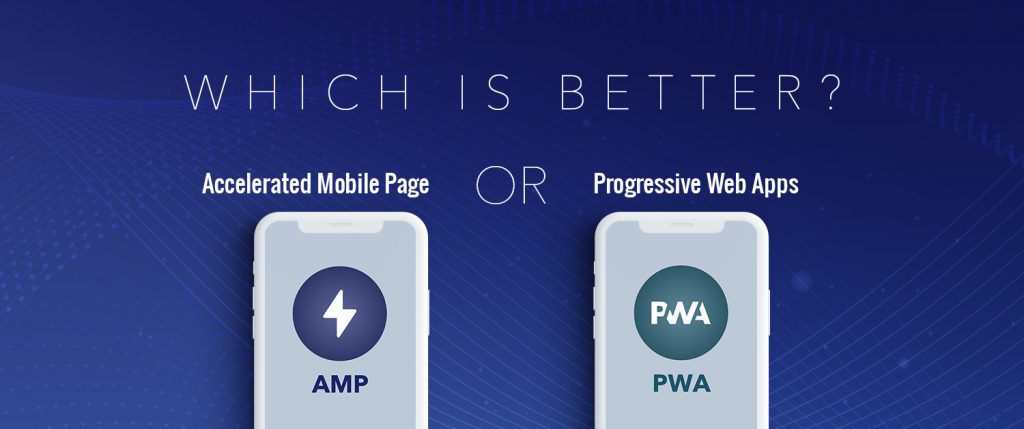
With technology in the most blooming form, mobility solutions have witnessed amazing heights of popularity. Adding the tinge of speed and simplicity to human lives, users can now gain access to the best-in-class services at the tip of fingers. While using the applications is just one part of the industry, developing them is altogether a hell of various confusions initially.
One such example is choosing between the Accelerated Mobile Pages and Progressive Web Apps. So here we are establishing what makes one better than the other, or helping you solve the puzzle of “what suits your business best?”.
Let’s get started!!!
But, what are the Accelerated Mobile Pages (AMP), by the way?
Accelerated Mobile Pages (AMP) is an open-source initiative that offers seamless web experience across various platforms. It extends outstanding coding capabilities to the developers that let them build web pages that are capable of loading instantly. The languages are basically the stripped down version of HTML and CSS that restricts the use of JavsScript.

Image Courtesy: AppsFlyer
What are the benefits of Accelerated Mobile Pages (AMP)?
#1. Growth in Traffic and SEO Ranking
Enhancing browsing experience is one of the most rewarding ways to attract great traffic to your website. AMP focusses on lightweight content does just that. Additionally, AMP sets a standard that helps the site owners decrease page load time. In doing so, they make the user experience better and also decrease the bounce rate significantly.
Additionally, AMP pages prioritize in the search algorithms and have a great impact on search engine result pages (SERP). If two sites rank similarly
Page load time also plays a big role in SEO, and since this initiative is being speared by Google, AMP pages are prioritized in their search algorithms and have a positive effect on search engine results pages (SERP). If two sites rank similarly when it comes to SEO, the one with the most speed gets priority.
#2. Low Bounce Rate and More Time On-Site
BbkbjkFaster loading pages increase the likelihood that your visitors will stay on your pages longer because the experience is fast and easy. According to a Google study, 53 percent of website visits are abandoned if a mobile site takes longer than three seconds to load. Publishers who implement AMP should see a decreased bounce rate, and potentially a 2x increase in time spent on a page.
#3. The Potential for Increased Ad Views
In AMP, the HTML is coded in a way to enhance the overall usability of banners and images. This means there should be a higher ad viewability rate, which can help publishers monetize their sites.
#4. Being Featured on the Google Search Top Stories Carousel Leads to a Higher Click-Through Rate (CTR)
One of the greatest benefits of AMP is that it showcases pages on the Google Search Top Stories carousel. When users search for content on their mobile devices, the carousel appears at the top of all searches, encouraging them to click this content first. Not only does the carousel benefit website owners with AMP pages because their content is featured first, but it also encourages non-AMP owners to focus on developing pages that are mobile friendly for consumers.
What are the Progressive Web Apps (PWA)?

Image Courtesy: Google
Simply put, a progressive web app is a native app delivered to the user through the internet. With functionality similar to the native apps, they help you keep the corresponding features like app-style gestures and navigation intact through the app shells. The best part is, all this without going through the long process of downloading and installing them. You have, and they enable you to run them through the web browser. In addition to this, they eliminate the requirement of manually updating the application making your lives much more comfortable, as they stay updated owing to the pre-caching.
What are the benefits of Progressive Web Apps (PWA)?
#1. They are App Marketplace Independent
As we said, with progressive web apps, you do not have to scroll through the available choices to finally get the application you need. Neither, the developers have to develop the apps that cater to the independent platform while satisfying the set of rules. Instead of two different versions, they can create one version that delivers the requirement across the devices. The developers also do not have to make manual updations frequently and instead launch the single updates that are automatically run on all the devices.
#2. Progressive Web Apps are Efficient
Progressive web apps beat the native apps in case of efficiency. While intelligently addressing the issue of customer buy-in, they offer you seamless native-like operation and features without taking too much of your device space or your data. Native apps not only confine you to the app stores but choosing them is a final decision, as the case with removing them.
#3. Progressive Web Apps are Cost-Effective
As highlighted, the progressive web application significantly reduces time-to-market. They develop faster and are easier to update. You can simply develop one version of the app and launch it for the people to use worldwide to deliver best-in-class features regardless of the screen size or the platform. This not only liberates you from the independent cost of developing native apps for each platform but also affects the time considerably thus proving a cost-effective alternative.
#4. Convincing Users to Go For your Native Apps is Challenging
According to a report by comScore, many users still download zero apps in a month. This shift drastically changes the way users and brands connect with each other and well establishes the need for the business to find alternatives to the native apps. Hence, to make a long-lasting mark in the industry, you need to have an exceptional native app that is capable of persuading the users to download and install it. The problem can be dealt with providing your business with a technological edge in terms of the progressive web apps, thanks to their flexibility. Probably this is the reason; it is becoming a popular choice among brands such as Google, Apple, and Microsoft.
#5. Progressive Web Apps are Device-Independent
The paradigms have changed drastically from the limitation of desktop computers to the wide range of devices that are mobile such as smartphones, laptops, palmtops, and more to add. This has affected many associated things like the way we browse through the internet. The users are now online round-the-clock while being a part of always-on-the-go society. This has also expanded the scope of brands to influence the users as you have access to them 24/7. Progressive web apps help you harness the benefits of this trend by delivering a seamless experience across the devices. Users can quickly switch between the desktops, laptops, palmtops, without any considerable difference between the interface or experience.
#6. More Engaging
Progressive web apps revolutionize the engaging experience for the users. They not only offer great features in a secure environment but also facilitate an easy route to reach out to the users who have stopped using the app. You can send them a push-notification and call them back to the app paving ways for the re-engagement.
AMP vs PWA
- Discoverability: AMP wins this battle. AMP gets the help of a carousel in Google search results, where progressive web apps aren’t afforded a boost in search engine discoverability.
- Engagement: Progressive web apps aren’t restricted to using AMP HTML or CSS, so they can include far more engaging content than AMP can. Anything interactive that requires JavaScript cannot be created using the AMP framework. For AMP, dynamic content is off the table.
- Speed: The edge here goes to AMP for the same reason progressive web apps win the engagement. AMP can only support lightweight content, but that makes for quicker load times.
- Features usage: Currently, while web apps can take advantage of a device’s features, native apps can more so. Things like GPS, push notifications, and gestures are more readily available in a native app.
- Content restrictions: To give your app a chance to compete in Google Play or the App Store, you’ll have to bend to the rules of the marketplace. Content restrictions and fees make it difficult for some websites to create successful native apps. For web apps, however, neither content restrictions nor fees are imposed, making it easier for anyone to create an app regardless of content type.
- Offline connectivity: Here, the edge goes to native apps, which offer more complete caching than progressive web apps built in HTML5. If your app has to work offline, currently the better choice is native.
- Installation: Installation of a native app requires significant action on behalf of the user. They have to open a marketplace and search for an app, then download. There has to be serious intent. For the installation of a progressive web app, there’s much less friction. Adding one to your device is like creating a bookmark on your home screen. It’s easier to install a progressive web app, but the process is much less familiar, which may inhibit early adoption.



